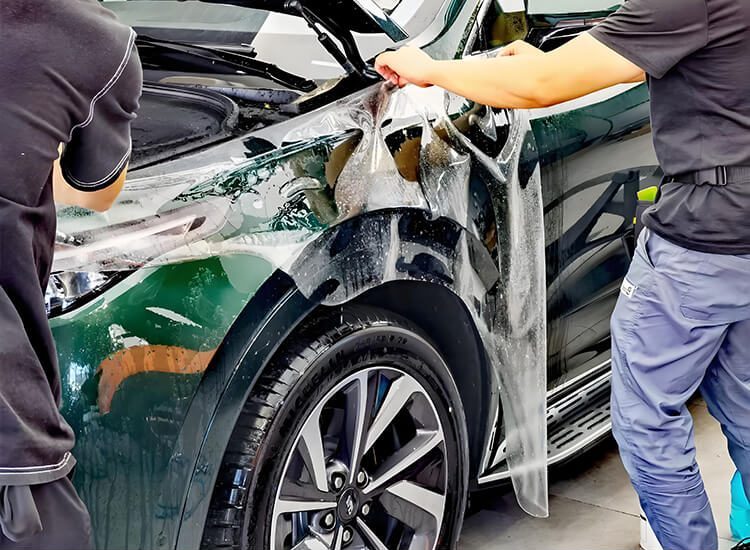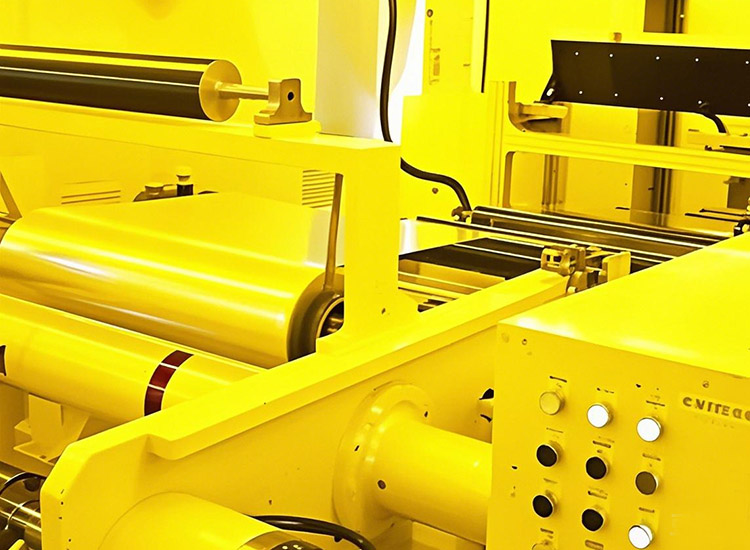Types of Paint Protection Film: Complete Guide
If you’re considering protecting your car’s paint, understanding the different Paint Protection Film options is a great starting point. Not all PPF is made equal, and choosing the wrong type could mean less durability, more maintenance, or wasted money. This guide will walk you through the most common types of paint protection film, explain the pros and cons of each, and help you choose the best one for your vehicle, budget, and driving habits.
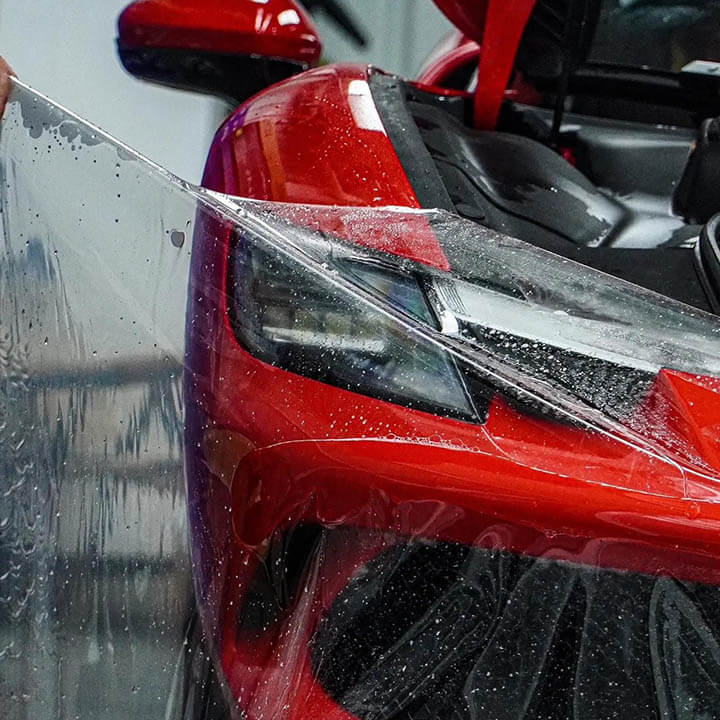
What Is Paint Protection Film
Paint Protection Film (PPF), also known as clear bra, is a thin, transparent film applied to a vehicle’s painted surfaces to protect them from scratches, rock chips, UV rays, and environmental contaminants. It’s one of the most effective long-term solutions to preserve your car’s finish and resale value. With so many Paint Protection Film Materials on the market today, it’s important to understand how they differ and which is right for you.
How Many Types of PPF Are There?
Choosing the right paint protection film (PPF) can feel overwhelming, especially with so many options on the market. But understanding how PPF is categorized can make your decision much easier. From the materials used to the finish, functional features, and installation methods, each type has its strengths. In this section, we’ll break down the most 6 common ways PPF is classified, so you can find the best fit for your vehicle, budget, and lifestyle.
1. By Material Type
This is the most fundamental way to classify PPF, as the material determines durability, clarity, self-healing ability, and overall performance.
- TPU (Thermoplastic Polyurethane): Premium choice with excellent flexibility and durability.
- PVC (Polyvinyl Chloride): Budget-friendly but prone to yellowing and cracking.
- TPH (Thermoplastic Hybrid): Middle-ground material with better performance than PVC but less than TPU.
- Sprayable PPF: A newer technology applied like paint, ideal for complex surfaces.

2. By Surface Finish
Surface finish affects the look of your car and how well it hides imperfections or enhances aesthetics.
- Glossy PPF: Makes your paint pop with a deep, shiny finish.
- Matte/Satin PPF: Reduces reflections and gives a unique stealthy look.
- Color-Tinted PPF: Adds a custom hue or style while offering protection.
- Chameleon/Color-Shift PPF: Shifts colors based on light and angle for dramatic effects.
3. By Coating Type
Some PPF products come with added coatings to make maintenance easier.
- Standard PPF: Basic protection with no special coatings.
- Ceramic-Coated PPF: Comes pre-coated with ceramic for enhanced water and stain resistance.
4. By Functional Features
Not all PPFs perform the same. Advanced films offer special features for added convenience and protection.
- Self-Healing: Minor scratches disappear with heat.
- Hydrophobic: Repels water and oil to keep your car cleaner.
- Chemical-Resistant: Withstands harsh contaminants.
- Track-Spec: Designed for high-performance and track-use vehicles.
5. By Installation Method
Different installation methods affect appearance, cost, and time.
- Pre-Cut Kits: Digitally tailored for your exact car model.
- Bulk Installation: Hand-cut by professionals for custom coverage.
- Spray-On PPF: Applied as a liquid for seamless, edge-free protection.
6. By Area of Coverage
PPF isn’t always full-body. Depending on your needs and budget, coverage areas vary.
- Partial Coverage: Covers only high-impact areas.
- Full Body Wrap: Maximum protection for every surface.
- Interior PPF: Guards touchscreen, trim, and high-touch interior areas.
Each has different characteristics in terms of clarity, durability, flexibility, and cost. While they all aim to protect your car, their performance varies depending on use cases and quality.

Common PPF Selling on the Market
With a growing demand for vehicle protection, the market now offers a wide range of paint protection films, each designed to meet different needs, preferences, and budgets. From advanced self-healing TPU films to budget-friendly PVC options, and from high-gloss finishes to matte or ceramic-coated variations, the choices can feel overwhelming. In the following sections, we’ll break down the most common types of PPF available today—highlighting their features, pros and cons, and helping you understand which might be the best fit for your car and lifestyle.
TPU Paint Protection Film
TPU is currently considered the gold standard among types of paint protection film. It’s extremely flexible, self-healing, and resistant to yellowing. This material provides the best combination of protection and aesthetic appeal, which is why it’s often used in high-end and luxury vehicles.
Pros
- Self-healing properties (heat-activated)
- UV-resistant and anti-yellowing
- Excellent clarity and finish
- Long lifespan (7–10 years)
Cons
- More expensive than other types
- Professional installation required
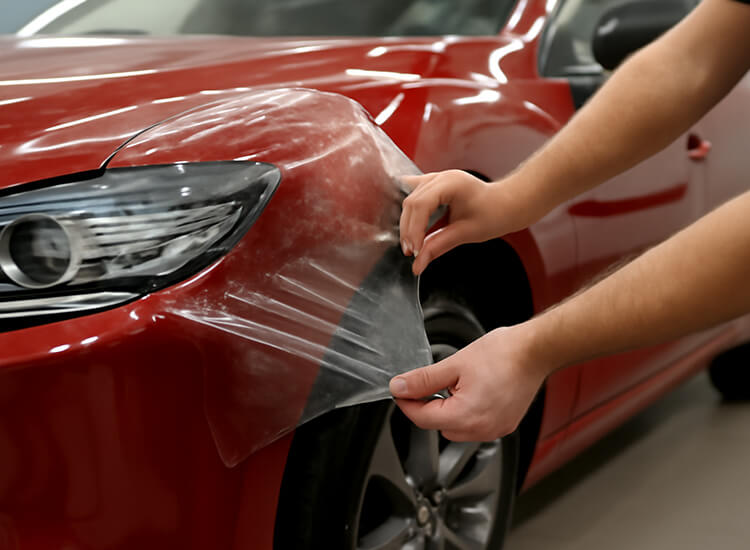
PVC Paint Protection Film
PVC used to be the most common material used in automotive paint film types, but it’s largely been replaced by TPU for performance reasons. However, it’s still available in the market as a budget option.
Pros
- Low cost
- Decent basic protection against scratches and debris
Cons
- Prone to yellowing over time
- Doesn’t self-heal
- Less flexible and more prone to peeling
TPH Paint Protection Film
TPH is a newer entrant that tries to balance between PVC and TPU. It uses hybrid technology to provide better flexibility than PVC, though it doesn’t match TPU in self-healing and durability.
Pros
- Mid-range cost
- Better flexibility than PVC
- Easier to install than TPU
Cons
- Limited self-healing
- May yellow or crack sooner than TPU
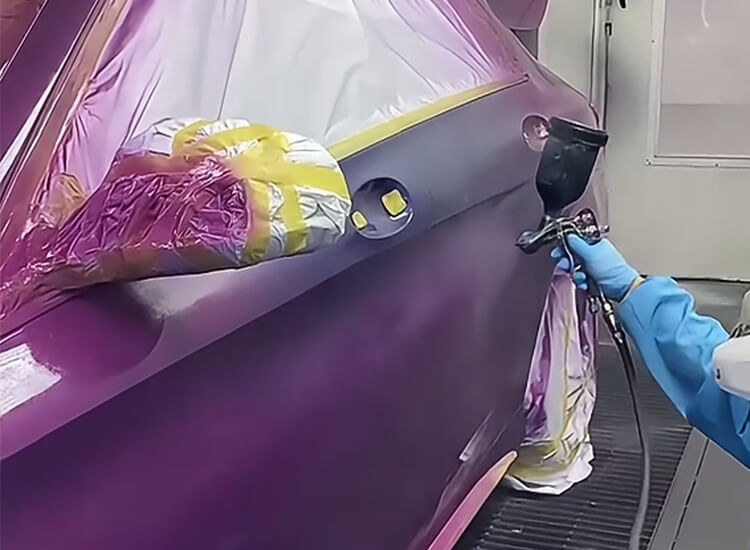
Sprayable Paint Protection Film (Liquid PPF)
Sprayable PPF is a newer technology that involves applying a liquid polyurethane solution directly onto the vehicle, where it cures into a protective film. It offers seamless protection and is ideal for complex surfaces and full-body coverage without visible edges.
Pros
- No seams or edges—perfect for complex curves
- Removable and replaceable
- Uniform coverage
- Can be repaired or re-coated in sections
Cons
- Requires a professional, highly skilled application
- Less common and more expensive
- Not as widely tested over time as TPU
Glossy vs. Matte Paint Protection Film
Choosing between glossy vs matte paint protection film depends on your aesthetic preference. Glossy PPF enhances the shine and depth of your car’s paint, making it look freshly waxed at all times. Matte PPF, on the other hand, offers a stealthy, satin look—perfect for custom finishes or a subtle upgrade.
Some manufacturers even offer dual-finish PPF options, combining protection with a unique custom look.
Ceramic Coated PPF vs. Regular PPF
Some TPU films now come pre-coated with a ceramic layer, creating what’s often referred to as ceramic-coated PPF. These films combine the hydrophobic benefits of ceramic coating with the durability of PPF. They’re easier to clean, more resistant to staining, and offer deeper gloss.
That said, ceramic-coated films tend to cost more. If you’re on a budget, applying a separate ceramic coating to regular TPU PPF is still a good alternative.
Which Paint Protection Film Is Best for Your Car?
That depends on your vehicle type, budget, and how you use your car. Let’s break it down:
PPF for Daily Drivers
If you’re looking to protect a daily driver from rock chips and road debris, TPU film is ideal due to its durability and self-healing qualities. But if the budget is tight, TPH may be a fair compromise. Make sure you calculate the PPF Usage Volume beforehand so you don’t over- or under-buy.
PPF for Luxury or Show Cars
High-end or collector vehicles deserve high-end protection. In this case, always go for premium TPU-based PPF. Choose a glossy or matte finish based on your car’s color and styling goals. Automotive PPF at this level often includes ceramic topcoats and extended warranties.
Best Paint Protection Film Type for Black Cars
Black cars show swirl marks, scratches, and blemishes more easily than lighter colors. We recommend a self-healing paint protection film with a self-healing topcoat. Some brands offer formulations specially designed to reduce surface imperfections in darker paints.
PPF Types Comparison Chart
| Feature | TPU | PVC | TPH | Sprayable PPF |
|---|---|---|---|---|
| Flexibility | Excellent | Poor | Good | Excellent |
| Self-Healing | Yes | No | Partial | Yes |
| UV Resistance | Excellent | Low | Moderate | High |
| Durability | 5–10 Years | 2–3 Years | 4–6 Years | 5–7 Years |
| Yellowing Resistance | Excellent | Poor | Moderate | Excellent |
| Cost(5*50ft) | $500 – $900 | $150 – $300 | $300 – $500 | $4,000 – $8,000 for a whole car |
| Ideal Use | Premium/luxury | Budget | Mid-range | Custom/high-end |
Clear Bra Film Types Explained
In the U.S., PPF is often marketed as clear bra. The clear bra film types available mirror the PPF categories discussed above—TPU clear bra, PVC clear bra, TPH clear bra, and even spray-on clear bra. While all serve the same purpose, they cater to different needs and price points. Premium clear bra films are typically multi-layered, offering both protection and visual enhancement.
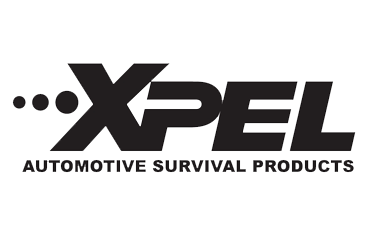
Top 5 Best-Selling PPF Brands on the Market
With so many paint protection film brands available today, it can be tough to know which one truly delivers on performance, durability, and value. To help you make an informed decision, here’s a breakdown of five of the most popular PPF brands currently leading the market. Each brand offers unique advantages suited for different vehicles, budgets, and protection goals.
🔝 Overview of 5 Popular PPF Brands
| Brand | Core Performance | Estimated Price (5×50ft roll) | Main Markets | Typical Users |
|---|---|---|---|---|
| XPEL Ultimate Plus | Premium TPU, self-healing, hydrophobic, non-yellowing | $850 – $1,200 | USA, Canada, Europe, Asia | Luxury & sports car owners, professionals |
| 3M Scotchgard Pro Series | Strong durability, stain resistance, reputable brand | $750 – $1,100 | Global | Daily drivers, luxury sedans |
| LLumar Platinum PPF | Self-healing, high optical clarity, UV protection | $700 – $1,000 | North America, Europe | High-end car owners, installers |
| STEK | Glossy TPU, water-repellent, anti-contamination | $800 – $1,100 | USA, Korea, Australia | Detailers, car enthusiasts |
| Hexis Bodyfence X | Flexible TPU, self-healing, matte & gloss options | $600 – $950 | Europe, Middle East | Sport/luxury car fans, matte finish lovers |
Tips for Buying and Using PPF
- PPF Coating Cost can vary widely based on film type, coverage area, and installer expertise.
- Quality PPF brands offer warranties ranging from 5 to 10 years.
- A bad install can ruin even the best film.
- Full-body wraps offer maximum protection but cost more.
- Even the best PPF needs regular washing and occasional detailing.
Looking for a Lower Cost PPF Solution?
If you’re searching for a high-quality yet budget-friendly paint protection film, consider trying the PreproPPF PR-Q01. Designed with daily drivers and cost-conscious car owners in mind, PR-Q01 offers durable TPU construction, self-healing performance, and easy installation—all at a fraction of the price of major brands. It’s a smart choice for those who want solid protection without overspending.
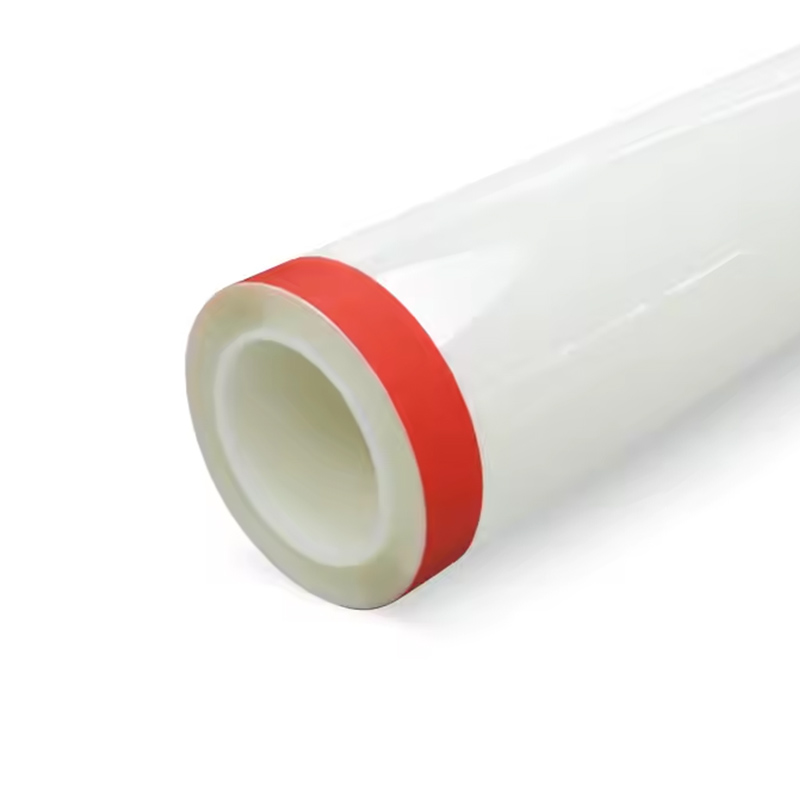
Frequently Asked Questions (FAQ)
How Long Paint Protection Film Last?
TPU is considered the best due to its self-healing and long-lasting properties.
TPU vs PVC paint protection film
TPU offers better clarity, flexibility, and durability, whereas PVC is less expensive but prone to yellowing and cracking.
Is ceramic-coated PPF worth it?
Yes, if you want added hydrophobic properties and less maintenance. Otherwise, applying a separate ceramic coat also works.
Glossy or matte PPF—which one is better?
Glossy enhances shine, while matte offers a stealthier, satin look. Choose based on personal style.
What is the lifespan of each PPF type?
TPU films can last up to 10 years with proper care; PVC typically lasts 2–3 years. Sprayable PPF usually lasts 5–7 years depending on quality and care.
